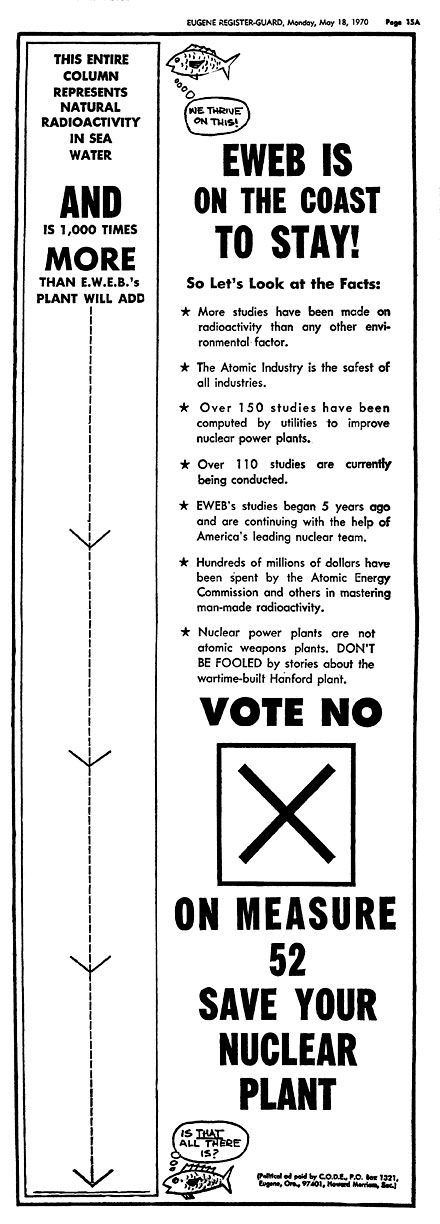- Catalog No. —
- Eugene Register-Guard, May 18, 1970
- Date —
- May 18, 1970
- Era —
- 1950-1980 (New Economy, Civil Rights, and Environmentalism)
- Themes —
- Environment and Natural Resources, Government, Law, and Politics
- Credits —
- Oregon Historical Society
- Regions —
- Coast Northwest Willamette Basin
- Author —
- Eugene Register-Guard
EWEB is on the Coast to Stay!
This political advertisement was paid for by Citizens for the Orderly Development of Electricity (CODE). It appeared in the Eugene Register-Guard on May 18, 1970, in opposition to ballot initiative Measure 52. Advanced by the Eugene Future Power Committee (EFPC), Measure 52 proposed a four-year moratorium on the construction of a 1.1 million kilowatt nuclear power plant by the Eugene Water and Electric Board (EWEB) in Florence on the Oregon coast.
In 1968, voters in Eugene overwhelmingly passed a bond measure allowing EWEB to construct a $225 million nuclear power plant in Lane County. At the time, estimates for the Pacific Northwest’s projected power needs showed a developing region quickly outpacing available energy sources. To address the projected shortfall, the Bonneville Power Administration (BPA), various public utility districts, and private electricity producers called for the large-scale development of nuclear power plants across the region.
To meet their projections for future power needs, EWEB, then under the leadership of Byron Price, hoped to supplement their BPA-supply of hydropower by locating a nuclear power plant in the Willamette Valley. However, farmers, worried about the effects of pollution upon their livelihoods, protested any plans that located the plant in the valley. EWEB first responded to their concerns by promoting the idea of using warm water, discharged from the plant’s reactors, as irrigation water for their crops. But, the farmers’ concerns were not alleviated and EWEB chose, instead, to build the plant on the Oregon Coast.
Additional criticism emerged in 1969. The EFPC was formed to protest what they considered to be a potentially dangerous and expensive power project. They argued that it was being pursued without sufficient public input and without adequate scientific research and planning. Finally, the EFPC decided to take their case directly to the voters of Eugene through a local ballot initiative designed to amend the city charter, putting a four-year moratorium on the plant’s construction. Their motto was simple: “We can wait. We should wait.” The EFPC gathered the required 4,528 valid signatures by February of 1970 and earned a spot on the ballot. In the meantime, proponents of the plant organized CODE to promote the benefits of EWEB’s nuclear power plant.
By the spring of 1970, EWEB and CODE advocated for the construction of a plant along the Oregon coast near Florence. They argued that Eugene desperately needed more electricity and jobs, that the plant would be “completely safe,” that “ocean cooling” of discharged waste water would “protect our environment,” and that delay would “increase plant cost by millions of dollars.” EWEB and CODE also stressed that the proposed power plant would emit “zero radiation release.” EWEB’s opponents continued to voice concerns over the plant’s safety and environmental effects and challenged the projections the utility used to support its arguments.
When the May 26 votes were finally tallied, opponents of the nuclear power plant scored an unprecedented victory, passing the moratorium by an 850-vote plurality. Four years later, EWEB abandoned its effort to build the plant.
Further References:
Pope, Daniel. “‘We Can Wait. We Should Wait.’ Eugene’s Nuclear Power Controversy, 1968 – 1970.” Pacific Historical Review 59, 1990: 349–373.
Written by Joshua Binus, © Oregon Historical Society, 2004
